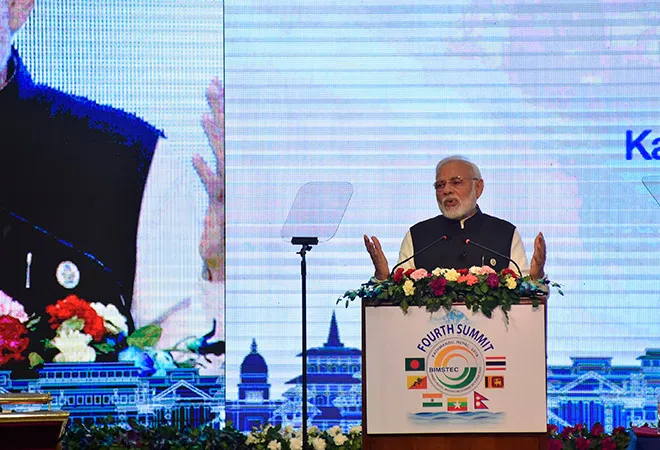
This article is part of the series — BIMSTEC in 2021.
Why has BIMSTEC appeared more prominently on India’s strategic radar since 2016 and is India really committed to making BIMSTEC emerge as a relevant regional institution? These are two questions that are frequently asked in the capitals of the seven member-states, from Kathmandu to Colombo and from Dhaka to Bangkok.
Why has BIMSTEC appeared more prominently on India’s strategic radar since 2016 and is India really committed to making BIMSTEC emerge as a relevant regional institution?
To avoid a mismatch of expectations and perceptions, one must place India’s BIMSTEC agenda in three contexts: It is driven by a geo-economic and connectivity imperative; this eastern connectivity effort coexists and competes with several other multilateral, regional, and bilateral initiatives; and despite improvements, BIMSTEC’s organisational capacity and autonomy remains limited to deliver.
Correcting the connectivity gap
India’s focus on BIMSTEC since 2016 is driven by a broader geo-economic reorientation towards deepening connectivity with the East. In 2018, India’s former Foreign Secretary, Vijay Gokhale, referred to the Bay of Bengal as a “subset of the growth region that we call the Indo-Pacific.” Clarifying India’s new geostrategic priorities, Prime Minister Narendra Modi had earlier emphasised “It is no surprise that the culmination of both India’s ‘Neighbourhood First’ and ‘Act East’ happens in this region of the Bay of Bengal.”
One should not, however, misunderstand India’s BIMSTEC policy after 2016 merely as a tactical response to the problems with Pakistan in the South Asian Association for Regional Cooperation (SAARC), nor as a strategic ploy to contain China. In fact, the focus on BIMSTEC is in line with India’s “Look East” policy that led to its creation, back in 1997. The year 2016, thus, marked more of a change in pace rather than direction.
The changing balance of power in Asia is one geostrategic reason for India’s investment in BIMSTEC.
The objective of regional connectivity is central to this Eastern reorientation. The changing balance of power in Asia is one geostrategic reason for India’s investment in BIMSTEC. But it would be incorrect to infer that BIMSTEC is just an Indian institutional vehicle to cut China out from its area of traditional influence.
In fact, it is questionable to what extent the Bay of Bengal is an area of Indian geostrategic primacy, given its abysmal levels of connectivity with the countries in the region. More than China’s growing presence in this space, the real anomaly is India’s relative absence from it, given geographic proximity. Besides strategic and security imperatives, India’s focus on BIMSTEC is thus primarily to correct the exceptional geo-economic connectivity gap between the subcontinent and Southeast Asia.
One objective, many ways
In New Delhi’s strategic parlance, “connectivity” and “BIMSTEC” are sometimes also used interchangeably. This confuses the means and ends: The regional organisation is one of many, different and mutually compatible ways by which India is pursuing its regional connectivity efforts to the East.
In New Delhi’s strategic parlance, “connectivity” and “BIMSTEC” are sometimes also used interchangeably.
Such variety of Indian approaches naturally poses a challenge for BIMSTEC, which will have to coexist and compete with other tracks, including the bilateral ones. For example, Indian efforts have pursued inland waterway navigation or motor vehicle connectivity agreements simultaneously at three levels: Bilateral arrangements, the sub-regional initiative called BBIN (Bangladesh, Bhutan, India, Nepal), and also through BIMSTEC.
Speaking shortly after taking office as India’s new External Affairs Minister in June 2019, S. Jaishankar pointed to BIMSTEC not only as an important regional organisation to pursue Indian interests in regional connectivity, but also emphasised that Delhi would be exploring multiple paths: “The thinking (in the government) really is any organisation or any platform that allows you to progress, you would like to use it.”
India will also have to be cautious not to take too many bilateral shortcuts and instead recognise that there are specific benefits to working through institutional settings.
Such diplomatic polygamy is a welcome and pragmatic departure from the traditional primacy of rigid and formal institutions to pursue regional cooperation. But India will also have to be cautious not to take too many bilateral shortcuts and instead recognise that there are specific benefits to working through institutional settings.
Limited organisational capacity
Another challenge relates to India’s capability to strengthen BIMSTEC’s institutional capacity and autonomy. As former Prime Minister Manmohan Singh cautioned in 2010, “We have created institutions for regional cooperation, but we have not yet empowered them adequately to enable them to be more pro-active.” While he was thinking of SAARC then, this remains equally valid today for BIMSTEC.
It is important to recognise that there has been a slow but positive progress, in particular after the 2018 summit held in Kathmandu.
In a 2017 paper by this author, the challenge was identified as a paradox between India’s high political investment in BIMSTEC and its bureaucratic delays to empower the organisation. Yet, it is important to recognise that there has been a slow but positive progress, in particular after the 2018 summit held in Kathmandu.
With 13 out of 18 points on BIMSTEC’s functioning, and a specific subheading on “institutional reform,” the summit’s declaration emphasised the “importance of robust institutional arrangements to effectively steer the process of regional cooperation under BIMSTEC.” Over the last two years, this has led to unprecedented work on a new organisational charter, the formalisation of a Permanent Working Committee, the expansion of the number of country directors deputed to the Secretariat in Dhaka, and a rationalisation in the number of working groups.
The way ahead
India’s growing interest in BIMSTEC reflects a geo-economic priority to correct the exceptional connectivity gap that continues to divide the Bay of Bengal region. But BIMSTEC will not enjoy any exclusivity and will have to coexist and compete with other connectivity initiatives.
BIMSTEC will have to coexist and compete with other connectivity initiatives.
On the other hand, while India’s focus on BIMSTEC has been articulated at the highest level, Delhi’s capability to translate such intent into practice by strengthening the organisation has been slower than expected and desired. Recognising these two developments will help us make a more realistic assessment about the potential and limitations of BIMSTEC to connect the Bay of Bengal region.
The views expressed above belong to the author(s). ORF research and analyses now available on Telegram! Click here to access our curated content — blogs, longforms and interviews.




 PREV
PREV


